Related Research Articles

The Kingdom of Jerusalem, also known as the Crusader Kingdom, was one of the Crusader states established in the Levant immediately after the First Crusade. It lasted for almost two hundred years, from the accession of Godfrey of Bouillon in 1099 until the fall of Acre in 1291. Its history is divided into two periods with a brief interruption in its existence, beginning with its collapse after the siege of Jerusalem in 1187 and its restoration after the Third Crusade in 1192.

The Battle of Hattin took place on 4 July 1187, between the Crusader states of the Levant and the forces of the Ayyubid sultan Saladin. It is also known as the Battle of the Horns of Hattin, due to the shape of the nearby extinct volcano of that name.
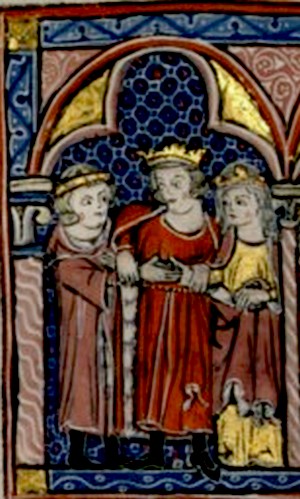
Humphrey IV of Toron was a leading baron in the Kingdom of Jerusalem. He inherited the Lordship of Toron from his grandfather, Humphrey II, in 1179. He was also heir to the Lordship of Oultrejourdan through his mother, Stephanie of Milly. In 1180, he renounced Toron on his engagement to Isabella, the half-sister of Baldwin IV of Jerusalem. The king, who had suffered from leprosy, allegedly wanted to prevent Humphrey from uniting two large fiefs. Humphrey married Isabella in Kerak Castle in autumn 1183. Saladin, the Ayyubbid sultan of Egypt and Syria, laid siege to Kerak during the wedding, but Baldwin IV and Raymond III of Tripoli relieved the fortress.

The Kingdom of Jerusalem, one of the Crusader states that was created in 1099, was divided into a number of smaller seigneuries. According to the 13th-century jurist John of Ibelin, the four highest crown vassals in the kingdom proper were the count of Jaffa and Ascalon, the prince of Galilee, the lord of Sidon, and the lord of Oultrejordain.
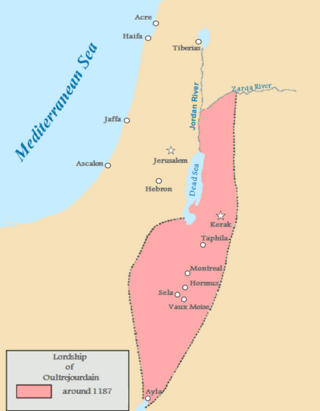
The Lordship of Transjordan was one of the principal lordships of the Kingdom of Jerusalem. It encompassed an extensive and partly undefined region to the east of the Jordan River, and was centered on the castles of Montreal and Kerak.
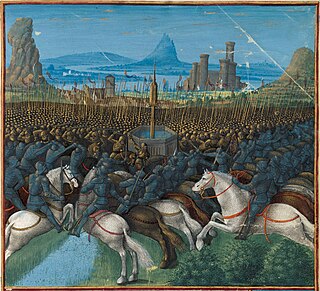
The Battle of Cresson was a small battle between Frankish and Ayyubid forces on 1 May 1187 at the "Spring of the Cresson." While the exact location of the spring is unknown, it is located in the environs of Nazareth. The conflict was a prelude to the decisive defeat of the Kingdom of Jerusalem at the Battle of Hattin two months later.
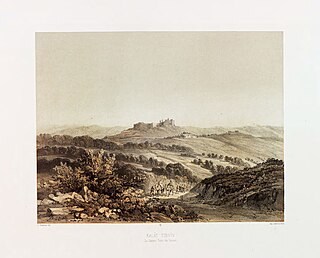
Toron, now Tibnin or Tebnine in southern Lebanon, was a major Crusader castle, built in the Lebanon mountains on the road from Tyre to Damascus. The castle was the centre of the Lordship of Toron, a seigneury within the Kingdom of Jerusalem, actually a rear-vassalage of the Principality of Galilee.
Miles of Plancy was a French-born nobleman who rose to high offices in the Kingdom of Jerusalem. He arrived in the kingdom during the reign of his kinsman King Amalric, who appointed him seneschal in 1168. Miles accompanied the king on two campaigns in Egypt. In early 1174 the king arranged for Miles to marry a great heiress, Stephanie of Milly, which made Miles lord of Oultrejordain, one of the largest fiefs in the kingdom. Amalric died on 11 July 1174 and was succeeded by his minor son, Baldwin IV. A regent was not immediately appointed to rule in the boy king's name, and so Miles duly assumed the government in his capacity as seneschal. He was of a too imperious temperament to cooperate with other noblemen, however, and soon caused resentment that led to his murder.

The principality of Galilee was one of the four major seigneuries of the crusader Kingdom of Jerusalem, according to 13th-century commentator John of Ibelin, grandson of Balian. The direct holdings of the principality centred around Tiberias, in Galilee proper, but with all its vassals, the lordship covered all Galilee and southern Phoenicia. The independent Lordship of Sidon was located between Galilee's holdings. The principality also had its own vassals, the lordships of Nazareth and Haifa.
The Lordship of Sidon, later County of Sidon, was one of the four major fiefdoms of the Kingdom of Jerusalem, one of the Crusader States. However, in reality, it appears to have been much smaller than the others and had the same level of significance as several neighbors, such as Toron and Beirut, which were sub-vassals.
The Lordship of Ramla was one of the lordships in the Kingdom of Jerusalem. It was vassal to and part of the County of Jaffa and Ascalon.
Eustace I Granier, also known as Eustace Grenier or Eustace Garnier, called in Latin Eustachius Granarius in the charters, was a Flemish crusader who took part in the First Crusade. He became lord of Caesarea in 1101, lord of Sidon in 1110, and in April 1123, was elected constable and bailiff of Jerusalem during the captivity of Baldwin II of Jerusalem. Shortly before his death, he defeated a Fatimid army at the Battle of Yibneh near Ibelin.

Tibnin is a municipality spread across several hills located about 25 km (16 mi) east of Tyre, in the heart of what is known as "Jabal Amel" or the mountain of "Amel". "Jabal Amel" designates the plateau situated between the western mountain range of Lebanon and Galilee.
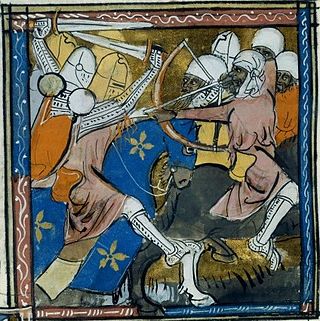
Hugh of Fauquembergues, also known as Hugh of St Omer, Hugh of Falkenberg, or Hugh of Falchenberg was Prince of Galilee from 1101 to his death. He was Lord of Fauquembergues before joining the First Crusade. Baldwin I of Jerusalem granted him Galilee after its first prince, Tancred, who was Baldwin's opponent, had voluntarily renounced it. Hugh assisted Baldwin against the Fatimids and made raids into Seljuk territories. He established the castles of Toron and Chastel Neuf. He died fighting against Toghtekin, Atabeg of Damascus.
The Lordship of Beirut was a feudal seigneury in the Kingdom of Jerusalem centered on the city of Beirut. The lord of Beirut was one of the most powerful vassals of the king of Jerusalem. In the 12th century the lordship was ruled by the Brisebarre family. At some point between 1165 and 1174, Beirut was taken back into the royal domain. Count Raymond III of Tripoli held it in 1185-86, and in 1187 it was conquered by the Ayyubids. It was recovered in 1197, and in the 13th century the lordship was held by the Ibelin family.

The Battle of Belvoir Castle, also called the Battle of Le Forbelet, was a part of Saladin’s campaign in May — August 1182 against the Crusaders. Crusader forces led by King Baldwin IV of Jerusalem battled with Ayyubid forces from Egypt commanded by Saladin. Saladin took action in Damascus on June 11, 1182, together with his regent Farrukh Shah. Entering Palestine from the south of Tiberias, Saladin encountered the Crusader army coming from Transoxiana near Belvoir Castle.
Humphrey III of Toron was a Frankish nobleman in the Kingdom of Jerusalem.

The Council of Tripoli was an assembly of the leaders of the crusader states in 1109, towards the end of the prolonged siege of the city of Tripoli. The crusader states—Jerusalem, Antioch, Edessa and the nascent Tripoli—had been established on lands in the Levant conquered by western European aristocrats during and in the aftermath of the First Crusade. Early in 1109, Jerusalem was ruled by King Baldwin I, Edessa by his vassal Count Baldwin II, Antioch by Tancred as regent for the absent Prince Bohemond, and the lands around Tripoli by Willam Jordan who had assumed the command of the troops besieging the city after the death of his kinsman Count Raymond. Relationship between Tancred and Baldwin II was tense, for Tancred had seized lands in the County of Edessa and refused to restore them to the Count. In April, Raymond's son, Bertrand, came to the Levant at the head of 4,000-strong army. He laid claim to lands held by Tancred and William Jordan, stating that he had inherited them from his father. William Jordan swore fealty to Tancred to secure his protection, whereas Bertrand accepted the suzerainty of King Baldwin I.

Pagan of Haifa was a 12th-century aristocrat in the Kingdom of Jerusalem. Few details of his life are known. He was the lord of Haifa c. 1109.
References
- ↑ Tibble 1989, p. 11.
- ↑ Tibble 1989, p. 12.
- 1 2 3 4 5 Pringle 1993, p. 222.
- 1 2 3 4 5 6 Murray 2006, p. 554.
- ↑ Tibble 1989, p. 52.
- ↑ Tibble 1989, p. 68.
- ↑ Tibble 1989, pp. 68–69.
- ↑ Tibble 1989, p. 69.
- 1 2 Tibble 1989, p. 75.
- ↑ Tibble 1989, p. 70.
- ↑ Tibble 1989, p. 76.
- ↑ Tibble 1989, p. 131.
- ↑ Pringle 1993, p. 223.